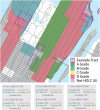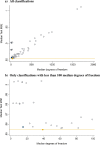Connecting past to present: Examining different approaches to linking historical redlining to present day health inequities
- PMID: 35587478
- PMCID: PMC9119533
- DOI: 10.1371/journal.pone.0267606
Connecting past to present: Examining different approaches to linking historical redlining to present day health inequities
Abstract
In the 1930's, the Home Owner Loan Corporation (HOLC) drafted maps to quantify variation in real estate credit risk across US city neighborhoods. The letter grades and associated risk ratings assigned to neighborhoods discriminated against those with black, lower class, or immigrant residents and benefitted affluent white neighborhoods. An emerging literature has begun linking current individual and community health effects to government redlining, but each study faces the same measurement problem: HOLC graded area boundaries and neighborhood boundaries in present-day health datasets do not match. Previous studies have taken different approaches to classify present day neighborhoods (census tracts) in terms of historical HOLC grades. This study reviews these approaches, examines empirically how different classifications fare in terms of predictive validity, and derives a predictively optimal present-day neighborhood redlining classification for neighborhood and health research.
Conflict of interest statement
The authors have declared that no competing interests exist.
Figures



Similar articles
-
Structural Racism, Historical Redlining, and Incidence of Kidney Failure in US Cities, 2012-2019.J Am Soc Nephrol. 2023 Sep 1;34(9):1493-1503. doi: 10.1681/ASN.0000000000000165. Epub 2023 Jun 12. J Am Soc Nephrol. 2023. PMID: 37303086 Free PMC article.
-
Race, historical redlining, and contemporary transportation noise disparities in the United States.J Expo Sci Environ Epidemiol. 2025 Jan;35(1):50-61. doi: 10.1038/s41370-024-00682-x. Epub 2024 May 17. J Expo Sci Environ Epidemiol. 2025. PMID: 38760532
-
Census Tracts Are Not Neighborhoods: Addressing Spatial Misalignment in Studies Examining the Impact of Historical Redlining on Present-day Health Outcomes.Epidemiology. 2023 Nov 1;34(6):817-826. doi: 10.1097/EDE.0000000000001646. Epub 2023 Sep 26. Epidemiology. 2023. PMID: 37732846
-
The Relationship of Historical Redlining with Present-Day Neighborhood Environmental and Health Outcomes: A Scoping Review and Conceptual Model.J Urban Health. 2022 Dec;99(6):959-983. doi: 10.1007/s11524-022-00665-z. Epub 2022 Aug 1. J Urban Health. 2022. PMID: 35915192 Free PMC article.
-
Methodologic Strategies for Quantifying Associations of Historical and Contemporary Mortgage Discrimination on Population Health Equity: A Systematic Review.J Racial Ethn Health Disparities. 2024 Sep 17. doi: 10.1007/s40615-024-02137-3. Online ahead of print. J Racial Ethn Health Disparities. 2024. PMID: 39289334 Review.
Cited by
-
A healing justice approach to grief in communities of color.Front Psychiatry. 2025 Apr 10;16:1508177. doi: 10.3389/fpsyt.2025.1508177. eCollection 2025. Front Psychiatry. 2025. PMID: 40276067 Free PMC article. No abstract available.
-
Connecting Past to Present: Does Historical Redlining Affect Current Life Expectancy?J Racial Ethn Health Disparities. 2024 Oct 28. doi: 10.1007/s40615-024-02220-9. Online ahead of print. J Racial Ethn Health Disparities. 2024. PMID: 39466535
-
Structural Racism and Pedestrian Safety: Measuring the Association Between Historical Redlining and Contemporary Pedestrian Fatalities Across the United States, 2010‒2019.Am J Public Health. 2023 Apr;113(4):420-428. doi: 10.2105/AJPH.2022.307192. Am J Public Health. 2023. PMID: 36888942 Free PMC article.
-
Segregation in hospital care for Medicare beneficiaries by race and ethnicity and dual-eligible status from 2013 to 2021.Health Serv Res. 2025 Apr;60 Suppl 2(Suppl 2):e14434. doi: 10.1111/1475-6773.14434. Epub 2025 Jan 11. Health Serv Res. 2025. PMID: 39797574
-
Historical Bias in Mortgage Lending, Redlining, and Implications for the Uncertain Geographic Context Problem: A Study of Structural Housing Discrimination in Dallas and Boston.J Urban Health. 2024 Oct;101(5):1037-1044. doi: 10.1007/s11524-024-00887-3. Epub 2024 Aug 21. J Urban Health. 2024. PMID: 39168963
References
-
- Faber JW. We Built This: Consequences of New Deal Era Intervention in America’s Racial Geography. Am Sociol Rev. 2020;85: 739–775. doi: 10.1177/0003122420948464 - DOI
-
- Aaronson D, Hartley D, Mazumder B. The Effects of the 1930s HOLC “Redlining” Maps. Federal Reserve Bank of Chicago; 2020. Report No.: 2017–12. Available: https://www.chicagofed.org/publications/working-papers/2017/wp2017-12
-
- Fishback PV, LaVoice J, Shertzer A, Walsh R. Race, Risk, and the Emergence of Federal Redlining. National Bureau of Economic Research; 2020. Nov. Report No.: 28146. doi: 10.3386/w28146 - DOI
-
- Aaronson D, Faber J, Hartley D, Mazumder B, Sharkey P. The long-run effects of the 1930s HOLC “redlining” maps on place-based measures of economic opportunity and socioeconomic success. Regional Science and Urban Economics. 2021;86: 103622. doi: 10.1016/j.regsciurbeco.2020.103622 - DOI
Publication types
MeSH terms
LinkOut - more resources
Full Text Sources
Miscellaneous

